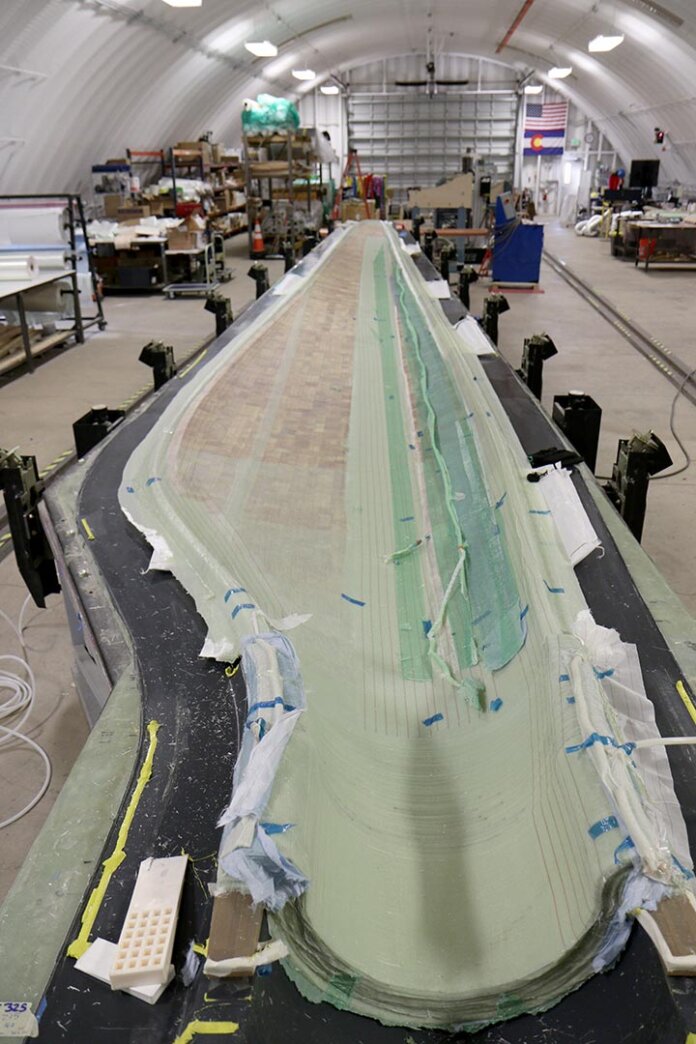A team of National Renewable Energy Laboratory (NREL) researchers are furthering their combination of recyclable thermoplastics and additive manufacturing (3D printing) to manufacture advanced wind turbine blades.
Today, most utility-scale wind turbine blades have the same clamshell design: two fiberglass blade skins are bonded together with adhesive and use one or several composite stiffening components called shear webs. This manufacturing process has been optimized for efficiency over the past 25 years.
To make wind turbine blades lighter, longer, less expensive and more efficient at capturing wind energy, researchers must rethink the conventional clamshell.
The NREL team, led by NREL senior wind technology engineer Derek Berry, is focusing on the resin matrix material. Current designs rely on thermoset resin systems like epoxies, polyesters and vinyl esters, polymers that, once cured, cross-link like brambles.
Once a blade is produced with a thermoset resin system, the process cannot be reversed and it makes the blade hard to recycle, explains Berry. As more and more wind turbines are installed every year, new wind turbine blades should be designed to be repurposed or even recycled to prevent them from undercutting the green economy they are meant to help build.
Working with the Institute for Advanced Composites Manufacturing Innovation in NREL’s Composites Manufacturing Education and Technology (CoMET) Facility, the multi-institution team developed systems that use thermoplastics, which, unlike thermoset materials, can be heated to separate the original polymers, enabling end-of-life recyclability.
Thermoplastic blade parts can also be joined using a thermal welding process that could eliminate the need for adhesives – often heavy and expensive materials – further enhancing blade recyclability.
“With two thermoplastic blade components, you have the ability to bring them together and, through the application of heat and pressure, join them,” Berry says. “You cannot do that with thermoset materials.”
Moving forward, NREL, along with project partners TPI Composites, Additive Engineering Solutions, Ingersoll Machine Tools, Vanderbilt University and the Institute for Advanced Composites Manufacturing Innovation, will develop innovative blade core structures to enable the cost-efficient production of high-performance, very long blades – well over 100 meters in length – that are relatively low weight.
By using 3D printing, the research team can produce the kinds of revolutionary designs needed to modernize turbine blades with highly engineered, net-shaped structural cores of varying densities and geometries between the structural skins of the turbine blade. The blade skins will be infused using a thermoplastic resin system.
If they succeed, the team will reduce turbine blade weight and cost by 10% or more, and production cycle time by at least 15%.
In addition to the prime AMO FOA award for additively manufactured thermoplastic wind turbine blade structures, two subgrant projects will also explore advanced wind turbine manufacturing techniques. Colorado State University is leading a project that also uses 3D printing to make fiber-reinforced composites for novel internal wind blade structures, with Owens Corning, NREL, Arkema Inc. and Vestas Blades America as partners.
The second project, led by GE Research, is dubbed AMERICA: Additive and Modular-Enabled Rotor Blades and Integrated Composites Assembly. Partnering with GE Research are Oak Ridge National Laboratory, NREL, LM Wind Power and GE Renewable Energy.




